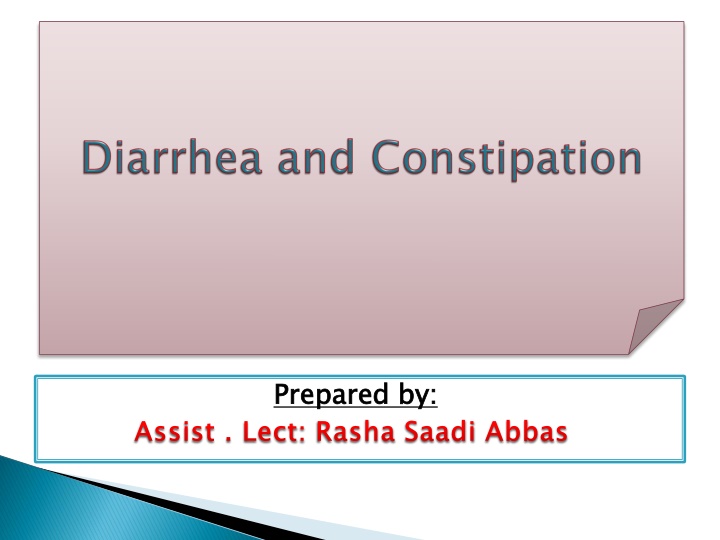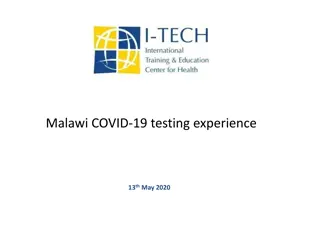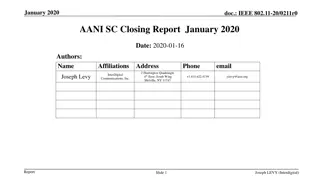
Diarrhea: Causes, Symptoms, and Treatment Guidelines
Learn about diarrhea, a common digestive issue characterized by abnormally soft or watery stools. Explore its causes, symptoms, and treatment guidelines to manage this condition effectively. Find insights on when to seek medical attention based on age groups and durations of symptoms.
Download Presentation

Please find below an Image/Link to download the presentation.
The content on the website is provided AS IS for your information and personal use only. It may not be sold, licensed, or shared on other websites without obtaining consent from the author. If you encounter any issues during the download, it is possible that the publisher has removed the file from their server.
You are allowed to download the files provided on this website for personal or commercial use, subject to the condition that they are used lawfully. All files are the property of their respective owners.
The content on the website is provided AS IS for your information and personal use only. It may not be sold, licensed, or shared on other websites without obtaining consent from the author.
E N D
Presentation Transcript
Prepared by: Lect: : Rasha Prepared by: Rasha Saadi Assist . Assist . Lect Saadi Abbas Abbas
Diarrhoea frequency passage of abnormally soft or watery faeces (more considered abnormal). is of defined bowel as an increased with evacuation, the than 3 bowel movement/ day is
1 1. . Age elderly patients are especially at risk of becoming dehydrated. 2 2. . Duration -Diarrhea of > 1-day duration in children < 1 year need referral. -Diarrhea of >2 days duration in children < 3 years need referral. -Diarrhea of > 3 days duration in older children and adults need referral. Age: : Infants (younger than 1 year) and Duration
- Acute produces frequently. - Chronic diarrhea may be due to an irritable bowel or, more inflammation colitis or Crohn s disease), an inability to digest or absorb food (malabsorption, e.g. coeliac disease) or diverticular disease of the colon. Acute diarrhea watery diarrhea: : is stools rapid in onset are and that passed Chronic diarrhea diarrhea: : Recurrent or persistent seriously, a bowel bowel tumor, ulcerative an of the (e.g.
- Abdominal cramps, flatulence, weakness or malaise. Nausea and vomiting, and fever---acute diarrhea (infective in origin). - Vomiting and fever in infants ---------- severe dehydration will develop. - Diarrhea in infants is whether the baby has been taking milk feeds and other drinks as normal. Reduced fluid intake predisposes to dehydration. - The presence of blood or mucus in the stools is an indication for referral. Diarrhea with severe vomiting or with a high fever would also require referral.
1. Viral: Viruses are often responsible for gastroenteritis. 2. Bacterial: These are the food-borne infections previously known as food poisoning. 3. Protozoan infections
Some drugs may cause diarrhea as : Antacids: Magnesium salts Antibiotics Antihypertensives: methyldopa; beta-blockers (rare) Digoxin (toxic levels) Diuretics (furosemide) Iron preparations Laxatives Misoprostol Non-steroidal anti-inflammatory drugs Selective serotonin reuptake inhibitors Treatment days. Treatment timescale timescale: : One day in children; otherwise 2
Oral rehydration therapy (ORS, ORT) Anti-motility drugs Antispasmodic Anti-Bacterial drugs Adsorbents and bulk forming drugs
1. Patients should be reminded that only water should be used to make the solution (never fruit or fizzy drinks) and that boiled and cooled water should be used for children younger than 1 year. 2. Boiling water should not be used, as it would cause the liberation of carbon dioxide. 3. The solution can be kept for 24 h if stored in a refrigerator. Fizzy, sugary drinks should never be used to make rehydration fluids, as they will produce a hyperosmolar solution that may exacerbate the problem. The sodium content of such drinks, as well as the glucose content, may be high. 4. Home-made salt and sugar solutions should not be recommended, since the accuracy of electrolyte content cannot be guaranteed, and this accuracy is essential, especially in infants, young children and elderly patients. 5. Special measuring spoons are available; their correct use would produce a more acceptable solution, but their use should be reserved for the treatment of adults, where electrolyte concentration is less crucial.
Amount of rehydration solution to be offered to patients. Quantity Under 1 year 50 mL (quarter of a glass) 1 5 years 100 mL (half a glass) 6 12 years 200 mL (one glass) Adult 400 mL (two glasses) Quantity of of solution solution Age Age (per (per watery watery stool) stool)














